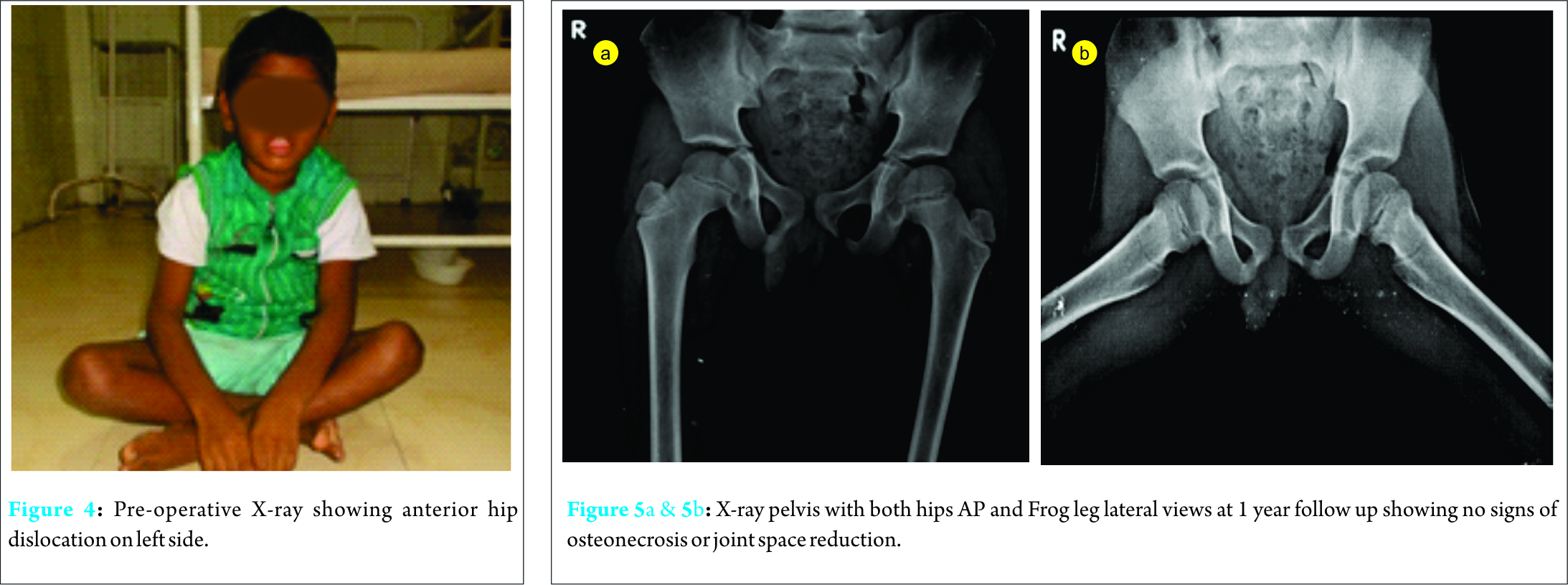[box type=”bio”] What to Learn from this Article?[/box]
Neglected anterior dislocation of hip in children is very rare and can be managed by open reduction through direct anterior approach.
Case Report | Volume 6 | Issue 3 | JOCR July-Aug 2016 | Page | Aditya Krishna Mootha, Kasi Viswanadam Mogali DOI: 10.13107/jocr.2250-0685.496
Authors: Aditya Krishna Mootha[1], Kasi Viswanadam Mogali[2]
[1]Department of Orthopedics, Konaseema Institute of Medical Sciences, Amalapuram. India.
[2]Department of Orthopedics, Rangaraya Medical College, Kakinada. Andhra Pradesh.
India.
Address of Correspondence
Dr. Aditya Krishna Mootha
15-8-5, Venkataratnapuram, Kakinada – 533001, Andhra Pradesh, India.
Email: akmootha2005@rediffmail.com
Abstract
Introduction: Post traumatic hip dislocations are very rare in children. Neglected anterior hip dislocations in children are not described in literature so far. Here, we present a case of 6 weeks old anterior hip dislocation successfully managed by open reduction.
Case Presentation: A 9 year old male child presented with neglected anterior hip dislocation on left side. Open reduction carried out through direct anterior approach to hip. Congruent reduction is achieved. At final follow up of 1 year, the child had unrestricted activities of daily living and no radiological signs of osteonecrosis or any joint space reduction.
Conclusion: There is paucity of literature over neglected post traumatic anterior hip dislocations in children. The treatment options vary from closed reduction after heavy traction to sub trochanteric osteotomy. However, we feel that open reduction through direct anterior approach is the preferred mode of management whenever considered possible.
Key Words: Hip dislocation, Anterior, Neglected, Paediatric
Introduction
Traumatic hip dislocations in children are rare injuries and account for less than 5% of all paediatric dislocations [1,2]. These are classified into anterior and posterior type and among this anterior dislocation in children is extremely rare injury [3]. The minimal trauma can produce dislocation in younger children because of generalized joint laxity and the acetabulum being soft with pliable cartilage. It is not uncommon to miss the diagnosis of dislocations of hip in children especially the posterior dislocation. There have been several cases of post-traumatic neglected posterior dislocation of hip in children. On the other hand, anterior dislocations are hard to miss because of the marked deformity. Though the exact definition of neglected hip dislocation is not clear, any hip dislocation left unreduced for more than 72 hours is considered to be “neglected” [4]. The literature on treatment of neglected dislocation in children is very sparse. To our knowledge, no case of neglected anterior dislocation of hip in children has been reported in the literature till date. Here, we report a case of anterior dislocation of hip neglected for 6 weeks in a nine year old child managed successfully by open reduction.
Case Report
A 9 years male child patient presented with history of fall from bicycle after which he was unable to bear weight on the left lower limb. He was treated elsewhere with splinting for 4 weeks. After removal of splint he was still unable to bear weight on the injured limb due to pain. At the time of presentation to us, the child has an antalgic gait. On clinical examination, he had deformity of flexion abduction and external rotation with painful restricted movements of hip suggestive of anterior dislocation of hip. Examination of opposite hip, spine and knees is normal. radiological examination confirmed the diagnosis [Fig. 1]. There were no associated fractures and distal neurovascular status was intact.
An open reduction of the joint through the anterior approach is planned and using the Somerville approach, the hip is approached . [5]. Acetabulum is exposed and cleared of pulvinar tissue. We passed 2.5 mm smooth k wire in to the femoral epiphysis though lateral cortex and neck to prevent separation of physis during reduction in to acetabulum. Lateral traction is applied with a bone hook under the neck of femur. Reduction is achieved with difficulty. Intra operatively, reduction is checked under fluoroscopy and is found to be stable, congruent and concentric through all range of motions of hip [Fig. 2]. K-wire is removed and capsulorraphy is done. Post operatively, skin traction is applied for 2 weeks. Post-operative period is uneventful and X rays confirmed the intraoperative congruency [Fig. 3]. Rehabilitation protocol included partial weight bearing after 2 weeks till 4 weeks. After 6 weeks the child is allowed to squat and sit cross-legged. At final follow up of 1 year, the child is able to perform all activities of daily living without any difficulty [Image 4] and X-rays showed no signs of osteonecrosis of head or any joint space reduction [Figs 5a, 5b].
Discussion
Post traumatic hip dislocation in children is a rare entity and its neglected type is much rarer [1].Traumatic anterior dislocations are less common than posterior type and neglected anterior dislocation is much more rare [1-3]. To our knowledge, there is no single case of neglected anterior dislocation in paediatric population reported in the literature so far. Post injury treatment of dislocation of hip becomes difficult with time. Ideal management includes closed reduction of hip under adequate sedation and analgesia as soon as possible. Unfortunately, this ideal may not be achieved in many developing countries because of difficulties in accessing the health care system and a lack of resources or trained health care professionals. Compared to adults, relatively slight trauma and a trivial fall can account for dislocation in children. This adds further to the delay in accessing the health care system in developing countries. With time, acetabulum becomes filled with fibrous tissue in unreduced dislocation so reduction becomes difficult by closed means. An unreduced hip in a child would not only leave behind a deformity, limp, and pain but also shortening of the limb and thinning of the bone attributable to the absence of stimulus to growth. The treatment options for reduction of old dislocation are closed reduction, closed reduction with heavy skeletal traction, open reduction. The alternatives to reduction as a primary treatment in unreduced dislocations in children include sub trochanteric osteotomy and symptomatic treatment until after skeletal maturity when a reconstruction can be performed. Closed reduction and manipulation under general anaesthesia could be done if dislocation is of short duration (2-4 weeks). Closed reduction with the extremity in heavy traction in abduction has been reported. The limb is placed in heavy skeletal traction (15–20% of the patient’s body weight) for 3–5 days, and portable radiographs are taken every other day. When the head of the femur is at the level of the acetabulum, the limb is gradually abducted to achieve reduction. Once the hip becomes concentric, the traction weight is reduced and maintained for additional 3 weeks. Buchanan et al concluded that although open reduction in old subluxation usually is difficult and not altogether devoid of danger, it was the best treatment [6]. In a review of the literature, Choyce et al reported open reduction in 15 neglected dislocations of hip in children and reported good results in nine children, satisfactory results in two children, and fibrous ankylosis in one child. The results were not reported for three children [7]. Verma et al did open reduction in 14 patients who had neglected injuries that were 14 days to 1 year old and reported excellent outcomes in four patients, good outcomes in four patients, fair outcomes in one patient, and poor outcomes in five patients [8]. Kumar and Jain et al in their study on 18 patients of neglected posterior dislocation treated them by open reduction because by skeletal traction dislocation could not be reduced. In their study, there was varying degree of avascular necrosis with preservation of head. They got excellent results in 17 patients [9]. All these studies support open reduction for neglected dislocations of hip but in these studies no single case of anterior dislocation of hip was described. There are few studies on neglected anterior dislocation of hip but all these include adults. Avinash Alva et al reported a case of a young man with 5 months neglected anterior dislocation of the hip. MRI of the hip confirmed avascular necrosis of the dislocated head of femur. A modified girdle stone operation was performed leaving the patient with a pain free functional hip [10]. N.D.Aggarwal and Hardas Singh reported 7 cases (20yrs to 68 yrs) of anterior dislocations treated with trochanteric osteotomy in 5 cases, open reduction in one case and arthroplasty in another case. Although the number of cases in this series is small, the authors feel that trochanteric osteotomy is the treatment of choice [11]. V S Pai reported 29 cases of dislocations of hip among these three are anterior dislocation. Closed reduction was done in one case, open reduction in one case and girdle stone in one case [12]. Based on all these studies it was understood that the treatment must be individualized because no method had been proven superior in the existing medical literature. Conclusions are difficult to draw because prior studies have included more than 1 treatment method in both adults and children. In the present case report ,we have reported a case of 9 years old child with neglected anterior dislocation of hip. We performed open reduction through anterior approach in our case and reduction was concentric. The child was able to squat and sit cross leg at 6 weeks of follow up and at 1 year of follow up he is able to do all daily activities without any difficulties. No radiological signs of osteonecrosis are present at a minimum follow up of 1 year.
Conclusion
In developing countries, it is not very rare to come across neglected trauma. We conclude that open reduction through direct anterior approach to hip is the treatment of choice in neglected post traumatic anterior dislocation of hip especially in paediatric population where salvage of the joint remains top priority
Clinical Message
Neglected traumatic anterior dislocation of hip in paediatric age group is rare and can be managed successfully by open reduction through anterior approach with necessary precautions.
References
1. Banskota AK, Spiegel DA, Shrestha S, Shrestha OP, et al. Open reduction for neglected traumatic hip dislocation in children and adolescents. 2007;27(2):187-91.
2. Canale ST. Fractures and dislocation in children in S T erry Canale and James H Beaty Campbell’s Operative Orthopaedics, Volume 2, Ed 11, p 1628-1630, 2008.
3.Funk F Traumatic dislocation of the hip in children. J Bone Joint Surg Am 1962;44(6):1135-1145.
4. Garrett JC, Epstein HC, Harris WH. Treatment of unreduced traumatic posterior dislocation of the hip. J Bone Joint Surg Am 1979;61:2-6.
5. Somerville EW and Scott JC. The direct approach to congenital dislocation of the hip. J Bone Joint Surg Br 1957;39-B(4): 623-40.
6. Buchanan JJ. Reduction of old dislocations of the hip by open incision. SurgGynecolObstet 1920;31:462.
7. Choyce CC. Traumatic dislocation of the hip in childhood and relation of trauma to paeudocoxalgia-analysis of fifty-nine cases published up to January 1924. Br J Surg 1924;12:52–59.
8. Verma BP. Management of old unreduced traumatic dislocation of the hip: A study of 29 cases. Indian J Orthop 1975;9:69–80.
9. Kumar S, Jain AK. Neglected traumatic hip dislocation in children. ClinOrthopRelat Res. 2005;(431):9-13.
10. Alva A, Shetty M, Kumar V. Old unreduced traumatic anterior dislocation of the hip. BMJ case reports 2013; doi:10.1136/bcr-2012-008068.
11. Agarwal N.D., Singh H. Unreduced anterior dislocation of hip. A report of seven cases. JBJS 1967;49(B):288-92.
12. Pai VS. The management of unreduced traumatic dislocation of hip in developing countries. Int. Orthop 1992;16:136–139.
| How to Cite This Article: Mootha AK, Mogali KV. A Rare Case of Neglected Traumatic Anterior Dislocation of Hip in a Child. Journal of Orthopaedic Case Reports 2016 July-Aug;6(3): . Journal of Orthopaedic Case Reports 2016 July-Aug: 6(3): . Available from: https://www.jocr.co.in/wp/2016/07/10/2250-0685-496-fulltext/ |
[Full Text HTML] [Full Text PDF] [XML]
[rate_this_page]
Dear Reader, We are very excited about New Features in JOCR. Please do let us know what you think by Clicking on the Sliding “Feedback Form” button on the <<< left of the page or sending a mail to us at editor.jocr@gmail.com







